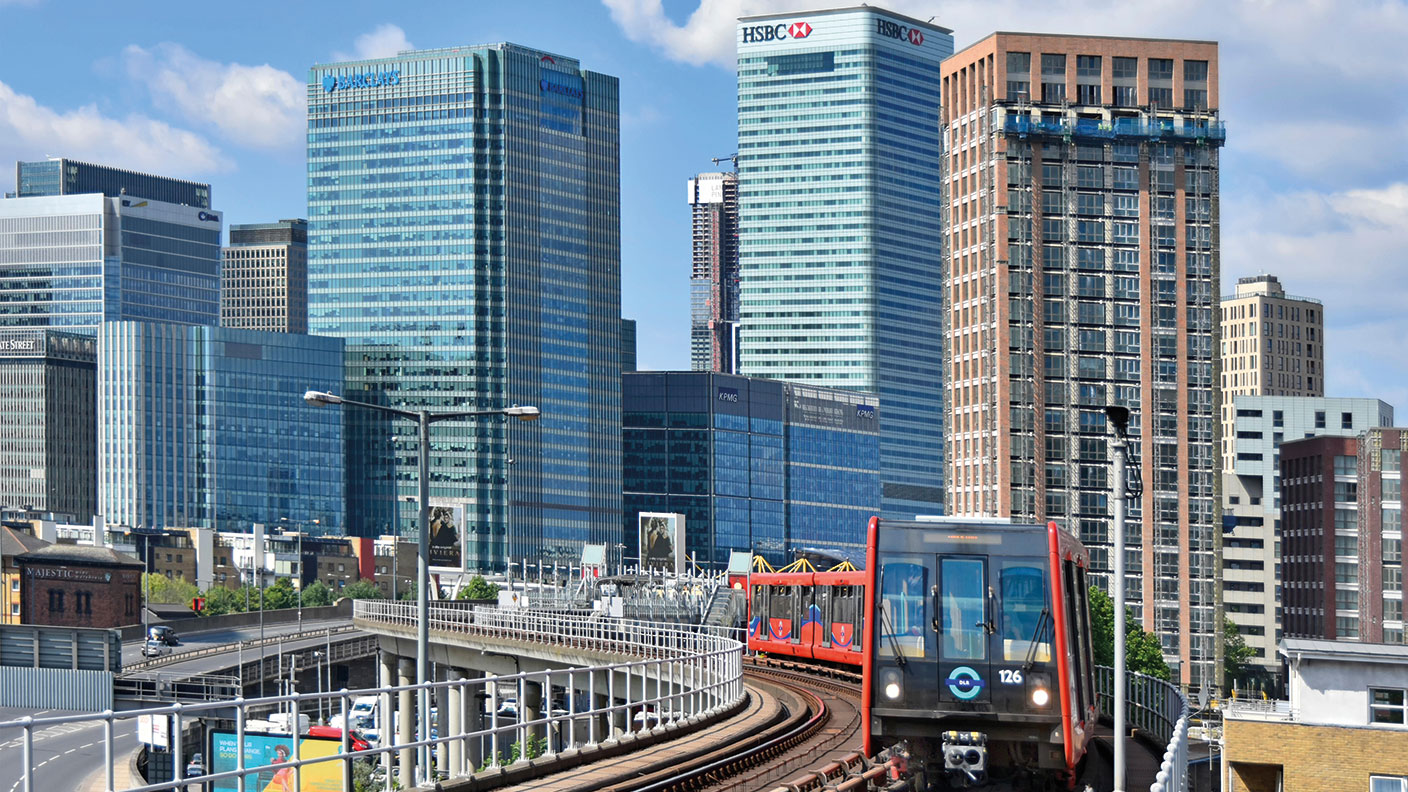When to buy shares in NatWest, Britain's worst bank
Rising interest rates should lift profits for the banking sector if inflation doesn’t get out of control, says Bruce Packard.


It’s hard to believe now, but UK banks’ share prices had a strong start to the year, up between 15% and 25% until mid-February. They reported results for the financial year ending December 2021 at the end of last month, with no obvious problems. We saw profits rebound and outlook statements suggest improving revenue and further capital returns to shareholders in the form of dividends and share buybacks. Then Russia invaded Ukraine and NatWest’s, HSBC’s and Lloyds’ share prices fell by more than 20% from their 2022 highs. Barclays has been hit even harder, down 30%. They have since rallied somewhat, but still remain down by between 12% (HSBC) and 22% (Barclays).
Direct exposure to Russia plays little part in this. UK banks have $3bn exposure to the Russian financial system, according to the Bank of International Settlements (BIS). While $3bn may sound like a lot of money, Austria (mainly Raiffeisen) has six times more exposure at $18bn. French (mainly Societe Generale) and Italian banks (Unicredit and Intesa Sanpaolo) have eight times more exposure at $25bn each. Societe Generale has said that it would be able to withstand the extreme scenario of having its Russian bank confiscated by the authorities, but so far banks have admitted losses that are in the tens of millions, not tens of billions.
Following the 2008 financial crisis, lenders are in much better shape to absorb losses, mainly because regulators demanded that they rebuild their capital ratios and fund with more equity. Excluding NatWest – which has sold businesses and shrunk total assets by a trillion dollars – the sector has now increased tangible equity funding by around $90bn in the last ten years. In total, UK banks have $420bn of equity to absorb losses. So while $3bn UK bank direct exposure to Russia might sound like a lot of money, it really isn’t compared with the equity on their balance sheets, and is much less than that of European competitors.
MoneyWeek
Subscribe to MoneyWeek today and get your first six magazine issues absolutely FREE

Sign up to Money Morning
Don't miss the latest investment and personal finances news, market analysis, plus money-saving tips with our free twice-daily newsletter
Don't miss the latest investment and personal finances news, market analysis, plus money-saving tips with our free twice-daily newsletter
Reassuring results
Results for the 2021 financial year were reassuring. Bank profits have been in long-term decline, but recovered in 2021. This was driven by lower bad debts compared with 2020, because banks took large provisions at the start of the pandemic and found that bad debts weren’t as high as the worst-case scenario. Hence statutory profit before tax doubled at HSBC and trebled at Barclays. The two banks the government rescued in 2008 fared even better, with Lloyds increasing profit before tax sixfold and NatWest recovering from a loss in 2020 to report a £4bn profit.
All UK banks have profitability (as measured by return on tangible equity – ROTE) targets of 10% or above and the outlook statements (which were written before the Russian invasion) sounded more confident that these can be achieved. For instance, HSBC said that it was likely to achieve at least 10% ROTE in the 2023 financial year, a year earlier than it had previously expected. Barclays and Lloyds already exceed their targets, reporting 13.4% and 13.8% ROTE respectively. This was helped by each bank’s revenue performance, but also a £0.7bn impairment release for Barclays and a £1.7bn release for Lloyds.
NatWest announced a £750m buyback; Barclays £1bn and Lloyds £2bn. The Asian-focused banks (HSBC and Standard Chartered), which are reporting lower returns and were trading on lower price to tangible book multiples, announced $750m and $1bn buybacks respectively. However, those buyback announcements have done little to support share prices. Since the obvious exposures to Russia’s economy are manageable, it’s the secondary and tertiary effects that share prices are responding to, and that’s what we should be thinking about as well.
Central banks have been slow to tighten
Merryn interviewed Andy Haldane, previously the Bank of England’s chief economist, for the MoneyWeek podcast in July last year. Haldane worried that other central bankers were too relaxed about the risk of inflation and that its effects might not be transitory. In June last year he was the only member of the Bank’s monetary policy committee (MPC) to vote to raise interest rates. He suggested that inflation could exceed the Bank’s 2% target for longer than most people expected, which would result in central bankers’ credibility being questioned.
Although central banks were slow off the mark in tightening policy, by the start of this year the strength of the post-pandemic economic recovery meant that most analysts were expecting to see steadily rising interest rates. You may be wondering: if interest rate rises have been expected, why the panic now?
Ultra-low interest rates are no good for banks, because banks make money from lending out their deposit funding. In normal times, customers’ deposits (which are liabilities on banks’ balance sheets) represent a cheap and stable source of funding. However, when interest rates are below 1%, banks don’t derive any benefit from this deposit funding, because there’s so much other liquidity freely available. As interest rates rise, banks will be slow to pass on the benefit to savings customers. Instead, net interest margins will widen (which is better for shareholders than it is for customers). As long as central banks are responding to a strong economy, rising interest rates are good news.
That was the bull case. But Russia’s invasion of Ukraine and the oil price rising to over $120 per barrel has changed the outlook.
The threat of stagflation
HSBC warned in its annual report that “further increases in energy prices – for instance, as a result of escalation in the Russia-Ukraine crisis – could keep inflation high and force central banks to tighten monetary policies faster than currently envisaged”. During the global financial crisis of 2008-2009, oil peaked at almost $150 per barrel – trebling from the $50 per barrel it traded at in January 2007. At the time a wiser, older broker told me: “Oil has never trebled in value and not caused a recession”. It wasn’t different that time and it probably won’t be different this time.
The problem is that we may see consumers’ disposable incomes being squeezed by higher commodity prices, rising inflation and rising unemployment all at the same time. That is what happened in the 1970s and it’s known as “stagflation” (stagnation + inflation). History shows that while quantitative easing might have helped stimulate growth from 2008 onwards, central banks can’t print their way out of a commodity shock. Longer term, rising inflation combined with rising unemployment is unambiguously negative for banks’ share prices. Any benefit from higher interest rates would be wiped out by bad debts.
These are the risks that share prices are reflecting. And if we see stagflation, investors should avoid the sector altogether. But if these fears are overstated, there could be some value in banks at this point.
The case for NatWest – Britain’s worst bank
A common-sense investment strategy is to pick a sector with favourable long-term prospects and buy a company from that sector that has favourable economics. An example might be Halma or Spirax Sarco in the engineering sector.
When it comes to UK banks, common sense works less well. The “quality” bank with the best long-term record is HSBC, whose share price has halved in value in the last 20 years. It’s not much good to point out that in relative terms HSBC has done better than the competition: Lloyds and NatWest were part-nationalised and shareholders diluted by the government in 2008. Barclays has fared little better, with the shares down by 70% compared with 20 years ago. In short, banks have not been “buy and hold” investments. With that in mind, I would suggest a different, counter-intuitive approach: wait until the tide is on the turn and then buy the lowest-quality bank, which is NatWest.
Expectations are low: NatWest lost money for nine consecutive years following the financial crisis. However, NatWest has essentially been three businesses i) a non-core shrinking “bad bank”; ii) good businesses that it was forced to sell as a result of receiving state aid (eg, Direct Line Insurance); and iii) a profitable core franchise. The years since the financial crisis have been dominated by the first two factors, but by their nature they have declined in importance and the core franchise should become more important.
NatWest’s annual report shows the bank should benefit by almost £1bn from a one percentage-point parallel shift in the sterling yield curve (that means short-term rates rise as the Bank of England raises the base rate, but the ten-year bond yield – which central banks don’t control – goes up by the same amount). That’s an automatic benefit equal to 25% of last year’s profit before tax of £4bn. As long as the yield curve remains upward sloping – meaning short-term rates (eg, 2%) remain lower than longer-term bond yields (eg, 4%) – some of that benefit is sustainable in future years.
Aside from the macro-economic background, there are still company-specific concerns. For instance, last year NatWest paid £466m of “conduct costs” for the financial year 2021, including £265m for money laundering for a Bradford jeweller that deposited £260m in cash, some in bin bags with a “musty smell”. Many of these problems were the result of cultural failings – and as the bank shrinks, it should become easier to avoid these hangovers from the past. Note also that the UK government still owns 52% (down from 97% in 2008), but not all of these shares are being placed on the market. Instead, NatWest is buying back from the government at the market price.
NatWest is trading on 0.5 times revenue and 0.6 times tangible book value. The forecast price/earnings ratio is less than six times forecast 2023 earnings, according to SharePad. That suggests investors believe it will deliver returns well below management’s target of 10% ROTE. But having shrunk its balance sheet by over £700bn in the last decade, the bank has been de-risked. The share price currently looks to be anticipating a very difficult stagflationary environment. The Ukraine war and sanctions may drive that scenario – but if we see commodity prices fall, that would be the signal the tide has turned, and would be the time to buy.
Get the latest financial news, insights and expert analysis from our award-winning MoneyWeek team, to help you understand what really matters when it comes to your finances.

Bruce is a self-invested, low-frequency, buy-and-hold investor focused on quality. A former equity analyst, specialising in UK banks, Bruce now writes for MoneyWeek and Sharepad. He also does his own investing, and enjoy beach volleyball in my spare time. Bruce co-hosts the Investors' Roundtable Podcast with Roland Head, Mark Simpson and Maynard Paton.
-
 What are my retirement income options?
What are my retirement income options?We’re all told to save into a pension, but there’s widespread confusion about how to take an income from our savings and investments at retirement, a new study has found. We look at your retirement income options.
-
 UK interest rates: will the Bank of England lower rates?
UK interest rates: will the Bank of England lower rates?The Bank of England’s Monetary Policy Committee’s (MPC) final interest rates meeting of the year takes place tomorrow (18 December) and most experts expect a cut
-
 British blue chips offer investors reliable income and growth
British blue chips offer investors reliable income and growthOpinion Ben Russon, portfolio manager and co-head UK equities, ClearBridge Investments, highlights three British blue chips where he'd put his money
-
 Coreweave is on borrowed time
Coreweave is on borrowed timeAI infrastructure firm Coreweave is heading for trouble and is absurdly pricey, says Matthew Partridge
-
 Renewable energy funds are stuck between a ROC and a hard place
Renewable energy funds are stuck between a ROC and a hard placeRenewable energy funds were hit hard by the government’s subsidy changes, but they have only themselves to blame for their failure to build trust with investors
-
 Profit from document shredding with Restore
Profit from document shredding with RestoreRestore operates in a niche, but essential market. The business has exciting potential over the coming years, says Rupert Hargreaves
-
 The war dividend – how to invest in defence stocks as the world arms up
The war dividend – how to invest in defence stocks as the world arms upWestern governments are back on a war footing. Investors should be prepared, too, says Jamie Ward
-
 Literacy Capital: A trust where great returns fund a good cause
Literacy Capital: A trust where great returns fund a good causeThere’s plenty to like about specialist private-equity trust Literacy Capital, says Max King
-
 An AI bust could hit private credit – could it cause a financial crisis?
An AI bust could hit private credit – could it cause a financial crisis?Opinion Private credit is playing a key role in funding data centres. It may be the first to take the hit if the AI boom ends, says Cris Sholto Heaton
-
 8 of the best ski chalets for sale now
8 of the best ski chalets for sale nowThe best ski chalets on the market – from a traditional Alpine-style chalet in Switzerland to an award-winning Modernist building in Japan’s exclusive ski areas